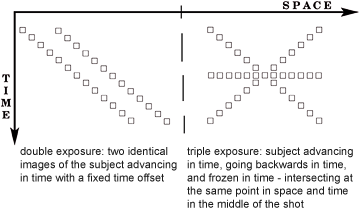FROZEN
MOMENT
LIVE
ACTION
STOP-
START
SLOW
MOTION
TIME
RAMP
SPACE
RAMP
TIME
BLUR
SPACE
BLUR
LONG
EXPOSURE
MULTIPLE
EXPOSURE
OPEN
FLASH
FLASH
TRAIL
LIGHT
PAINTING
MOTION
DISTORTION
MATCH
CUT
UNIVERSAL
CAPTURE
|
TECHNIQUES - MULTIPLE EXPOSURE
Multiple exposures are relatively simple to achieve in both still photography and cinema - one simply exposes the image multiple times. To record multiple exposures with Digital Air's camera systems each individual camera's shutter opens two or more times during a single take and as a result two or more images of the subject appear in the same shot with a time offset.
This technique can be combined with a sequential shutter effect so that, for example, a person can walk through a shot with an identical synchronous double following just behind. These doubles may also accumulate or disappear over time as in the example below.
Any number of multiple exposures can be achieved - literally thousands if desired.
The multiple exposure technique can be captured in camera by opening and closing our system's shutters, by leaving the shutters open and using strobes, or by a combination of both shutter and strobe timing. Multiple exposures can also be created in post by adding multiple frames together.

| |
 photo: Andrew Davidhazy
photo: Andrew Davidhazy
|
EXAMPLE - MULTIPLE EXPOSURE

Project: BMW 3 Series commercial
Equipment: Timetrack™ 160 lens straight / curved camera
Client: BMW
Director: Michel Gondry
Production Company: Partizan (LA)
Producer: Julie Fong
Post Production: Twisted Labs (Olivier Gondry)
link to finished spot: https://vfx.digitalair.com/bmw1.html
| |

This example illustrates how multiple exposures can progressively accumulate or disappear over time by lighting a scene with multiple strobe pops and progressively closing or opening the shutters across a Timetrack™ camera system. In this example the strobes were controlled by our 160 lens Timtrack camera and even the headlights on the moving car were strobes.
|
|
|